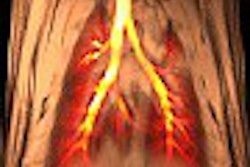(Radiology Review) Radiologists at Aristotele University of Thessaloniki, Greece, presented detailed information regarding cortical laminar necrosis in brain infarcts on MRI in Neuroradiology.
Their objective was to better define the MRI appearances, in particular chronological changes in signal intensity and contrast enhancement using a number of techniques. According to the authors, long-standing brain infarcts usually show low signal on T1-weighted scans and high signal on T2-weighted images.
"High-signal cortical lesions are observed on T1-weighted images in cases of brain infarct. Histological examination has demonstrated these to be cortical laminar necrosis, without hemorrhage or calcification," they reported.
The necrosis is due to ischemia with gliosis and deposition of fat-laden macrophages, and appears in the late subacute and chronic stages of cerebral hypoxia, they wrote. The authors analyzed 12 patients over a three-year period that had high-signal laminar cortical lesions on T1-weighted images without calcific or hemorrhagic lesions on CT.
Patients underwent CT upon admission and on the day of their MRI, with serial scans from day six through to 1.5 years. "The basic protocol included T1-weighted and T2-weighted axial spin-echo images, and contrast enhancement with gadolinium diethylenetriamine-pentaacetic acid 0.1-0.2 mmol/kg," according to the authors. Signal intensity was classified as low, isointense, or high compared with the cortex.
In the early stages (up to two weeks), lesions demonstrated low or isointense signals on T1-weighted images. After two weeks, the T1-weighted images showed high-intensity signals that peaked at 1-2 months. These high intensity signals gradually reduced in intensity after the two-month follow-up scan. Enhancement was not shown during the first two weeks following infarct. Enhancement was strongest from two weeks to three months, after which time enhancement gradually paled.
The authors added, "although the mechanism of T1 shortening in cortical laminar necrosis remains unclear it is believed to reflect neuronal damage and reactive tissue change, with reactive gliosis and deposition of fat-laden macrophages."
Cortical laminar necrosis in brain infarcts: serial MRISiskas, N. et, al.
AHEPA University Hospital, Aristotele University of Thessaloniki, Greece
Neuroradiology 2003 May, 45:283-288
By Radiology Review
July 30, 2003
Copyright © 2003 AuntMinnie.com



.fFmgij6Hin.png?auto=compress%2Cformat&fit=crop&h=100&q=70&w=100)




.fFmgij6Hin.png?auto=compress%2Cformat&fit=crop&h=167&q=70&w=250)











